
The night sky is filled with numerous stars. It is not possible to observe all of the stars with the unaided eye, as faint celestial bodies go unnoticed. Utilizing astronomical instruments, over 3000 stars have been documented in the visible part of the sky, with twice as many in the sky of both hemispheres. Ancient Greek seafarers utilized the starry sky for navigation, and descriptions of certain constellations date back as early as the 4th century BC.
What is a constellation
A constellation refers to a gathering of stars in the night sky that appear to be in close proximity to each other when viewed from Earth. Astronomers have divided the entire celestial sphere into different sections, and stars that are observed within the same region are grouped together as a constellation. During the congress of astronomers in 1922, the boundaries for the 88 constellations were officially established.
Although the distances between the sites of constellations can be vast, they are not actually part of the same cluster, which is an important aspect to consider when discussing the story behind a constellation.
The constellation Virgo, for example, contains over 2.5 thousand galaxies. The light from these galaxies takes approximately 1.3 billion years to reach Earth, allowing astronomers to observe the distant past of the Universe.
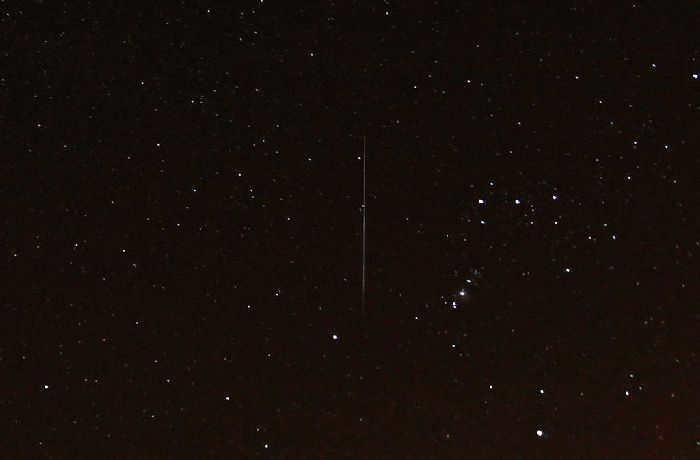
Ancient Civilizations and their Interpretation of the Stars
In ancient times, people would observe the brightest stars and connect them together, forming various shapes and figures such as mythical creatures, gods, and even musical instruments. These observations would eventually lead to the creation of star maps by scientists.
Astronomy enthusiasts would be familiar with Jan Hevelius’s famous atlas of the starry sky, which features traditional depictions of constellations. This atlas was published in 1687 and has become a valuable resource for studying the night sky.
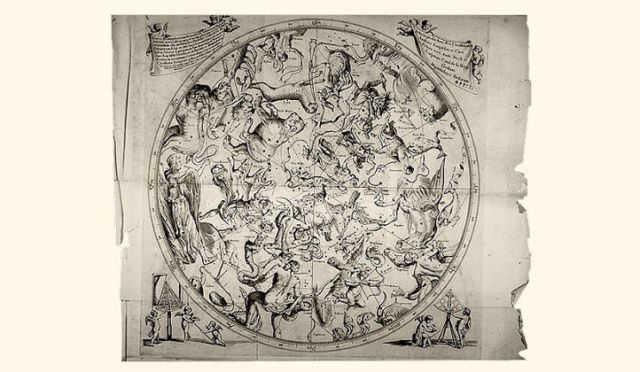
Astrological star groups
The pattern or circular path that the Sun, Moon, and planets of our solar system follow is known as the zodiac or zodiacal circle. The constellations that fall within this circle are referred to as the zodiacal constellations.
At present, there are 12 constellations that make up the zodiacal circle, with 3 constellations assigned to each season.
From the North Pole to the 80th southern parallel, the constellation of Cancer can be observed. Approximately 2,000 years ago, the Sun was positioned at the summer solstice within this constellation, leading to the naming of the Northern Tropic as the Tropic of Cancer.
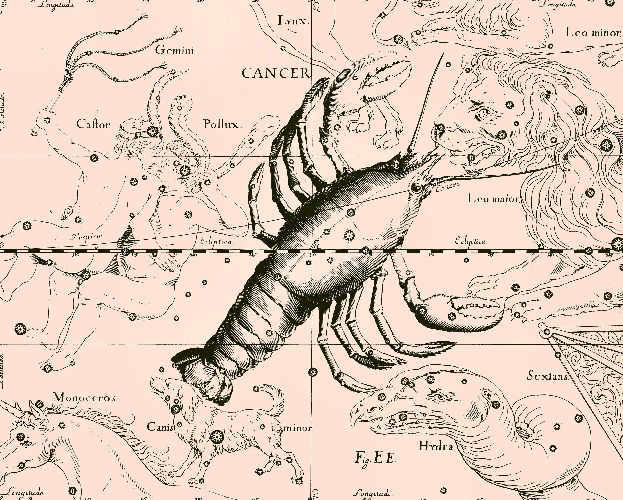
The constellation Sagittarius
Sagittarius is home to numerous nebulae, globular clusters, and an impressive 22 stars with their own planetary systems. It is also notable as the current position of the Sun during the winter solstice. Additionally, Sagittarius holds the distinction of being the central point of the Milky Way Galaxy, which includes our own Solar System. This constellation can be observed from the South Pole all the way up to the 55th north parallel.
What have we discovered?
In the sky, there are 88 constellations – groups of stars that appear to be close to each other. Among them, 12 are zodiacal constellations. Some information about these constellations can be included in a lesson about “Constellations” for second-grade students learning about the world around them.
Children develop an interest in the universe from a very young age. They eagerly absorb knowledge about the world around them and what could be more captivating than gazing up at the sky, observing hundreds of twinkling dots, and contemplating what they are.
However, space is a realm filled with mysteries and unanswered questions! Explaining what it is, especially to children, is not an easy task. Providing “adult” answers can confuse and bewilder young listeners.
Certainly, this does not imply that you ought to refrain from addressing the matter – rather the opposite, as your audience lacks any preconceived notions, so now is the opportune moment to discuss science and exploration with them. It is simply a matter of elucidating concepts in a manner that children can readily comprehend, participate in, and develop an interest in the subject.
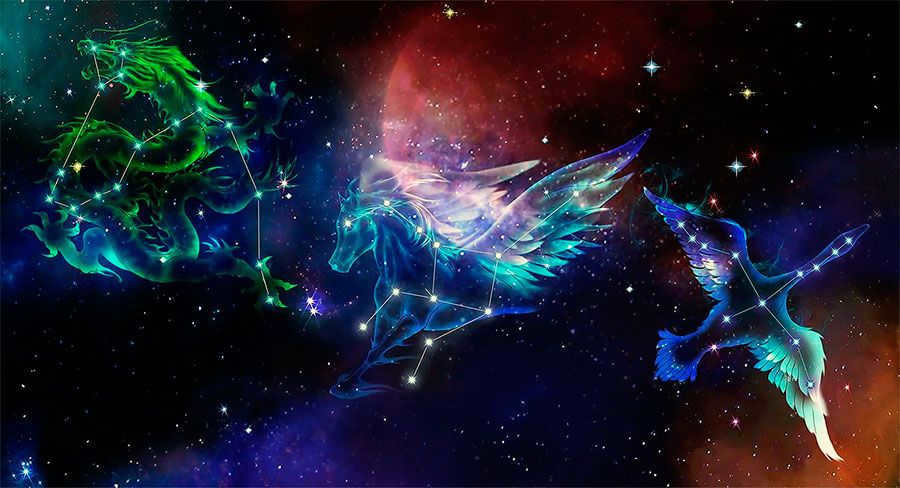
Here is a compilation of 10 intriguing facts about constellations that are sure to pique your curiosity. Take a look below for a detailed explanation of each one.
- How many constellations can be observed in the night sky?
- Which constellation holds the title for being the largest?
- Who was responsible for naming the constellations?
- Which constellation is considered the smallest?
- Are constellations always visible to the naked eye?
- How many animal figures can be found among the constellations?
- Do fixed stars exist within constellations?
- How has knowledge of constellations benefited people throughout history?
- Which constellation is the easiest to locate?
Alright, children, it’s time to find simple answers to truly astronomical inquiries!
Two crucial inquiries about outer space for children
However, before we proceed, it’s essential to acknowledge two pressing questions that were not initially included in my list, but without their answers, nothing will be accomplished.
What is a star?
If you ever need to explain to a student what stars are, here’s a simple way to put it: a star is essentially a massive, luminous orb composed of gas that is located at such a tremendous distance from us that we are unable to observe it in great detail, only perceiving it as a tiny, radiant speck. It’s worth noting that our very own Sun is classified as a star as well, and if you were to view it from another star, it would similarly appear as a diminutive, glowing point.
In the event that additional inquiries arise, such as “why do stars undergo combustion?”, you can readily respond by stating that stars burn because they contain a significant quantity of gas within them.
What is the definition of a constellation?
After comprehending the concept of a star, we can delve into the explanation of constellations: a constellation can be defined as a cluster of stars that coexist in close proximity. By mentally connecting these stars using lines, similar to connecting dots in a coloring book, the resulting formations can resemble animals, humans, or various other objects.
When it comes to the question of “Which animals do constellations resemble?”, the possibilities are quite diverse. For instance, constellations can resemble bears, bulls, lions, snakes, and even fish.
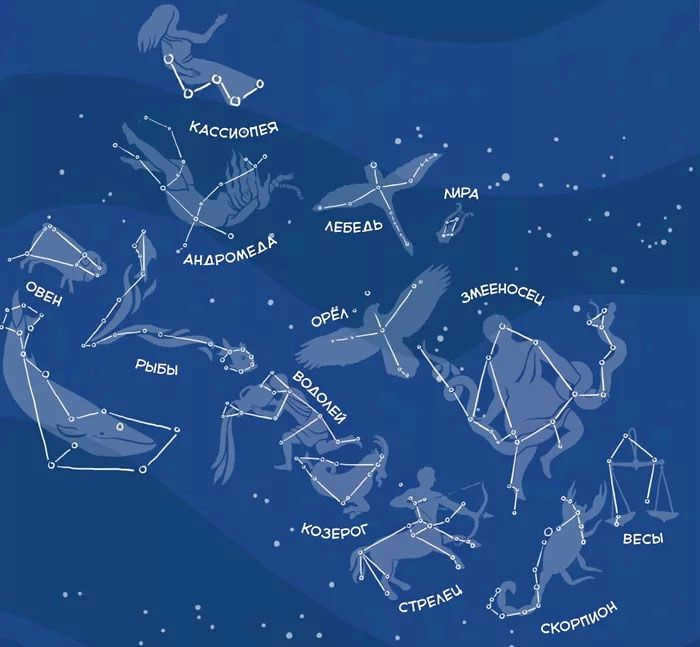
Interesting facts about constellations for kids
1. How many constellations are there in the night sky?
There are currently a total of 88 constellations in the night sky. The International Astronomical Union, a group of scientists dedicated to promoting astronomy, compiled the current list of constellations. It is possible that in the future, new constellations will be added to the list. You can find the current list of constellations here.
2. Which constellation is the largest?
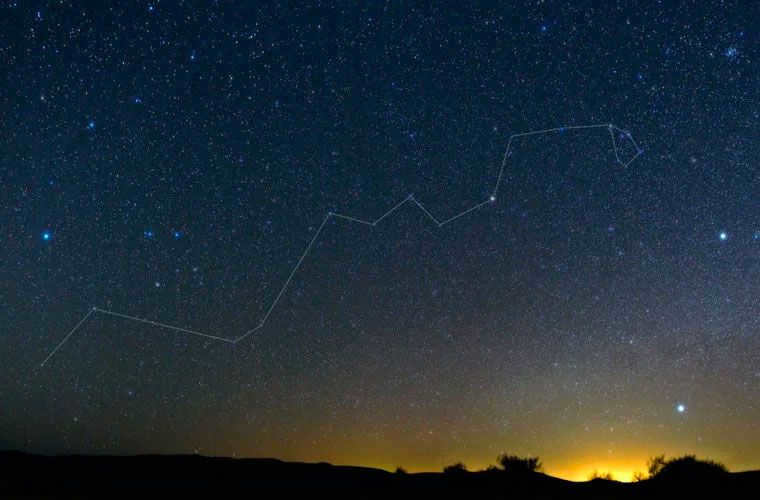
The constellation Hydra spans the entire sky, making it the largest of all known constellations.
3. Who was responsible for naming the constellations?
The majority of constellations were named by the ancient Greeks, who were brave sailors in the distant past. While other civilizations also used the stars for navigation and agriculture, it is the ancient Greek names that have endured and persisted to this day.
The Greeks also crafted most of the fantastical and mythological stories associated with each constellation. These stories often revolve around the exploits of ancient gods and heroes, as seen in the example of Hydra above.
The ancient Greeks recognized 48 constellations, as opposed to the modern count of 88, because some constellations are only visible in specific regions of the planet.
4. What is the tiniest constellation?
The tiniest constellation is known as the Southern Cross, which has a delightful and memorable name. Although we are uncertain about who named it, we do know precisely why it was given this title – the “Southern Cross” comprises only four stars and takes the shape of a cross. In terms of the area it occupies in the night sky, it is indeed the smallest among all the other constellations.
Due to its positioning in the sky, the Southern Cross can only be seen in the southern hemisphere of the Earth. Unfortunately, it is not visible at all from the territory of Russia.
5. Can constellations always be observed?
There are both yes and no answers to the question of whether there are constellations above our heads all the time. Yes, because there are always constellations present, but no, because the specific constellations change throughout the year. This is due to the Earth’s orbit around the Sun, which causes our position in outer space to constantly shift. It’s similar to being in a moving car, where the view outside the window changes as you move.
Some constellations can only be seen at certain times of the year, while others take their place. The cycle repeats each year, with last year’s constellations becoming visible again. If you remember the position of a zodiacal constellation like Cancer, Fish, or Leo in the sky, exactly one year later, all of its stars will be in the same positions once again.
6. How many animals “inhabit” the sky?
To honor the animal kingdom, including both real and mythical creatures, a total of 42 constellations have been named after them. This makes up almost half of all constellations! Here is a list of these constellations, with their Latin names provided in parentheses:
- Ursa Major (Big Bear)
- Canis Major (Big Dog)
- Lupus (Wolf)
- Corvus (Raven)
- Canes Venatici (Hounds)
- Dove
- Hydra
- Delphinus (Dolphin)
- Draco (Dragon)
- Grus (Crane)
- Camelopardus (Giraffe)
- Lepus (Hare)
- Dorado (Goldfish)
- Serpens (Snake)
- Monocero (Unicorn)
- Capricornus (Capricorn)
- Cetus (Whale)
- Cygnus (Swan)
- Volans (Flying fish)
- Vulpecula (Fox)
- Leo (Lion)
- Ursa Minor (Little Bear)
- Canis Minor (Small dog)
- Equuleus is a small horse
- Leo Minor is a small lion
- Musc is a fly
- Aquila is an eagle
- Aries
- Pavo is a peacock
- Pegasus
- Apus is a bird of paradise
- Cancer
- Lynx
- Pisces
- Scorpius
- Taurus
- Tucana
- Phoenix
- Chamaeleon
- Hydrus is the southern hydra
- Piscis austrinis is the southern fish
- Lacerta is a lizard
7. Are there any fixed stars?
All stars change position in the sky when viewed from Earth. All except one! One single star always stays in place and never moves, it is called Polaris. It’s part of the constellation Little Bear.
Why is this star not moving quickly? The reason is that Polaris is very closely aligned with the Earth’s axis. If we imagine the Earth as a spinning top, Polaris would be at the very top of the handle. No matter where you look from on the Earth, even though it is constantly rotating, the handle of the spinning top will always be visible in the same spot.
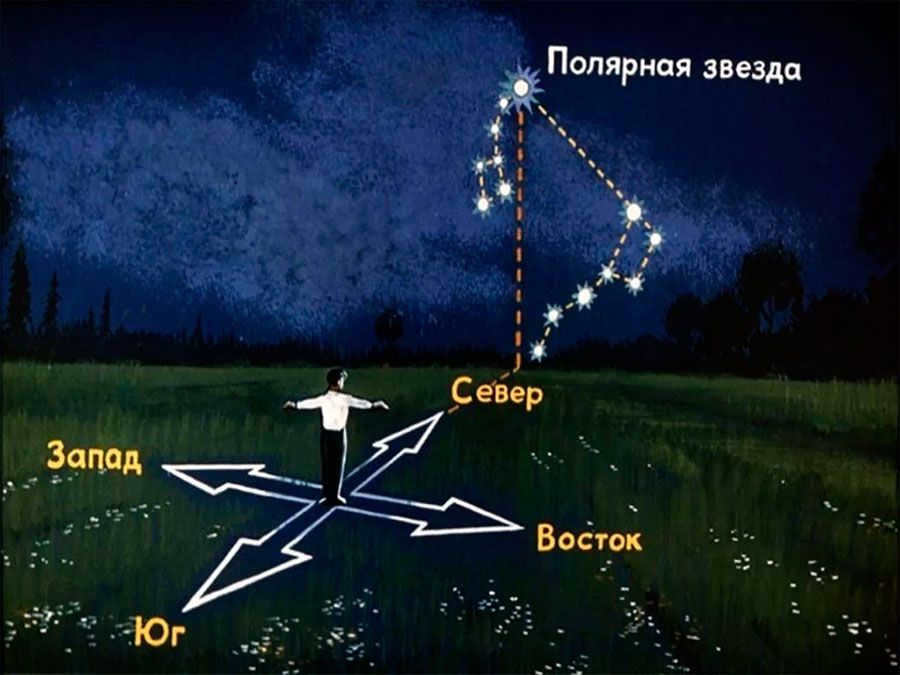
If you possess the knowledge of locating the Polaris star, then you possess the ability to navigate through the landscape as well.
8. How has the understanding of constellations benefitted humans in the past?
In ancient times, constellations served as a guide for navigation – it is no wonder the ancient Greeks were known for their bravery at sea! When phones, compasses, and other modern navigation tools were not available, people relied on the stars and constellations during their travels.
By familiarizing themselves with the appearance of constellations from their home location and observing how the positions of the stars changed overhead in real-time, sailors could accurately determine their current location and navigate towards neighboring countries or back home.
9. Which constellation is the most easily identifiable?
When it comes to the territory of Russia, the most easily identifiable constellation is the Ursa Minor, as it is home to Polaris, which is highly visible from our country. Once the Ursa Minor is located, it becomes effortless to locate the Ursa Major. And once both are found, it becomes easy to recognize all the neighboring constellations.
Additionally, the Orion constellation is relatively easy to locate – simply look for three bright stars that are closely positioned and aligned in a straight line. These stars form the famous “Orion’s Belt,” which is situated at the very center of this constellation.
10. How do constellations move across the sky?
The constellations have a continuous motion across the sky from the East to the West, similar to the Sun and Moon. However, it is important to note that it is not the constellations themselves that are physically moving above us. Instead, it is our planet Earth that revolves around the Sun and rotates on its axis. This motion gives us the opportunity to witness new perspectives of the constellations on an hourly basis, as if we were on a spaceship’s deck, peering through a colossal porthole and marveling at the awe-inspiring imagery of the vast cosmos.
Author: Alexander Frolov, for the site “Star Catalog” (starcatalog.ru).
This content is based on the translation of an article from the website littleAstronomy, as well as information freely available from internet resources.
Constellations are distinct groupings of stars that scientists have classified together due to their formation of various figures in the sky.
Ancient civilizations categorized stars into constellations using various methods. Furthermore, the stars visible in different regions of the world vary.
The International Astronomical Union (IAU), including Russia, extensively researched and utilized the constellations identified by astronomers from the Mediterranean. In 1922, the IAU officially acknowledged 88 constellations as legitimate. This comprehensive list encompasses 49 ancient constellations that were originally identified by the Romans and Greeks, as well as contemporary constellations.
Compilation of constellations
Arrangement of constellations
Naturally, not all stars combine to form constellations, as there are over a hundred billion of them. Consequently, constellations consist only of the most luminous stars.
Scientists have divided the sky into regions of various shapes and sizes. Any stars falling within a particular section of a constellation are considered part of that constellation.
All of the stars visible in the sky belong to the Milky Way galaxy. However, depending on the time of year (based on the Earth’s position in its orbit around the Sun), we can observe different constellations.
Constellations in the Southern and Northern Hemispheres
When we are in the same hemisphere, we observe the celestial dome above us. The sky covers approximately 180 degrees of the entire spherical shape of our planet, Earth.
In each hemisphere, people can only see the constellations that are directly overhead. To view the constellations on the opposite side of the sphere, one must move to the other hemisphere.
Imagine standing on an orange and gazing upwards. You can only see the space above the orange, which represents the Southern Hemisphere. The space below the orange is not visible to you.
As a result, scientists have categorized constellations based on whether they are visible in the Southern Hemisphere or accessible to residents of the Northern Hemisphere.
The constellations in the Southern Hemisphere include:
- The Canis Major (The Big Dog)
- Lupus (The Wolf)
- Corvus (The Raven)
- Columba (The Dove)
- Sagittarius (The Archer)
- Artist,
- Crane bird,
- Jackrabbit,
- Golden carp,
- Native American,
- Kielbasa,
- Goat fish,
- Magnetic compass,
- Feeding,
- Flying fish,
- Microscopic examination device,
- Insect,
- Pumpkin,
- Magic wand,
- Measurement instrument,
- Colorful bird,
- Sailing ship,
- Heating appliance,
- Tropical bird,
- Woodworking tool,
- Gridiron,
- Scorpion,
- Mountainous landmark,
- Archer,
- Astronomical telescope,
- Tropical bird,
- Mythical bird,
- Color-changing lizard,
- Centaur,
- Circle,
- Timepiece,
- Drinking vessel,
- Armor,
- Southern water snake,
- Southern crown,
- Southern fish,
- Southern cross,
- Southern triangle.
The constellations in the Northern hemisphere include:
- Andromeda
- Gemini
- the Big Dipper
- the Volopassus
- Veronica’s Hair
- Hercules
- Hound Dogs
- Dolphin
- Dragon
- Giraffe
- Cassiopeia
- Swan
- Lyra
- Foxy
- Little Bear
- the Lesser Horse
- Little Leo
- Aries
- Pegasus
- Perseus
- Cancer
- Lynx
- Northern Crown
- Sextant
- Arrow
- Triangle
- Cepheus
- Lizard
Astrological Constellations
The astrological zodiac comprises a collection of constellations encircling the Earth.
As the Earth orbits the Sun, an imaginary line called the ecliptic becomes visible, representing the path along which the Sun moves across the sky throughout the year.
These constellations, known as zodiacal constellations, are the ones intersected by the Sun’s ecliptic.
They are also referred to as the zodiac signs and encompass a total of 12:
- Aries,
- Taurus,
- Gemini,
- Cancer,
- Leo,
- Virgo,
- Libra,
- Scorpio,
- Sagittarius,
- Capricorn,
- Aquarius,
- Pisces.
Origin of constellations
Astronomer and mathematician Claudius Ptolemy created the initial catalog of constellations around 140 B.C. This compilation featured a total of 48 constellations, which have existed for thousands of years.
These constellations were named after various gods and mythical figures, including Orion, Cepheus, Pegasus, Andromeda, and more. Many of these constellations remain familiar to us today.

Claudius Ptolemy (on the left) was a scientist who developed a geocentric model of the universe, in which the Earth is positioned at the center and all other planets orbit around it. However, this model was later replaced by the heliocentric model, which states that the Earth and other planets revolve around the Sun.
A more modern atlas called Uranometria was created in 1603 by the German astronomer Johann Bayer. This atlas is notable because it accurately depicts the positions of stars, as observed through the latest precision telescopes, with a difference of only 1 angular minute.
Why constellations are essential
Constellations have been crucial for navigation and orientation on land since ancient times.
The understanding of constellations enabled people in the past to identify the seasons without relying on calendars. Stars were used to determine the ideal time for planting and harvesting crops.
Due to the Earth’s rotation around its axis and the Sun, constellations appear in different positions in the sky depending on the time of year. For instance, the constellation Orion becomes most prominent as winter approaches.
Constellations are divisions of the celestial sphere used for navigation in the night sky. In ancient times, constellations were known as distinct patterns created by prominent stars.
Overview
In three-dimensional space, stars that appear close together on the celestial sphere can actually be located far apart. Throughout history, people have recognized patterns in the arrangement of stars and organized them into constellations based on these patterns.
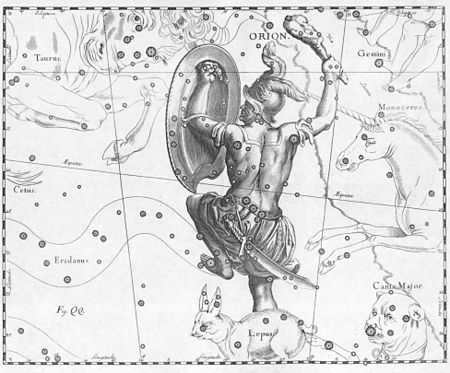
The list of 88 constellations, which divide the starry sky, was officially approved in 1922 in Rome at the I General Assembly of the International Astronomical Union. In 1928, clear and unambiguous boundaries were established between these constellations, following the lines of direct ascension and declination of the equatorial coordinate system at the epoch of 1875.0. Over the course of five years, the boundaries of the constellations were adjusted. In 1935, the final boundaries were approved and have remained unchanged since. It is important to note that due to the Earth’s axis precession, the boundaries of the constellations no longer align with the lines of direct ascension and declination. This means that star charts created for different epochs, including modern ones, will show shifted boundaries for the constellations.
List of celestial formations
The International Astronomical Union has officially acknowledged a total of 88 celestial formations. The table also encompasses the names in Latin, both in the nominative and genitive cases[1], official abbreviations, area measured in square degrees, and the quantity of stars that are brighter than magnitude 6.0. The table allows for sorting by any parameter for convenience.
Embracing Diversity
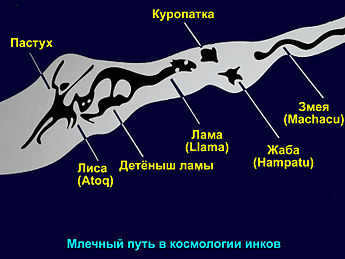

In ancient times, travelers relied on the celestial sky as their navigational compass. They ingeniously connected the most radiant stars, forming shapes that were associated with Greek mythological heroes, animals, and various objects. As new stars were unearthed, the boundaries of these constellations naturally evolved. However, in 1935, astronomers made the decision to cease further alterations to the established constellation boundaries.
A constellation is commonly known as a group of stars that are in close proximity to each other. However, this is not entirely accurate. Allow me to provide the accurate definition of a constellation.
In modern astronomy, a constellation refers to specific regions in the sky where the traditional constellations are situated. There are a total of 88 such regions. This division into sections has facilitated star navigation, as each section encompasses numerous stars and galaxies, including those that have traditionally been associated with the constellation.
The most significant constellations
In terms of importance, the constellations of the Big Dipper and Little Dipper have held a prominent position for a long time in the Northern Hemisphere. These constellations have played a crucial role in accurately determining the northern position by using Polaris as a reference point. Additionally, Cassiopeia, another constellation, is constantly visible in the night sky.
Figure 1. A photograph of the Cassiopeia constellation taken by the Spitzer Space Telescope.
Within the Southern Hemisphere, there exists a significant constellation known as the Southern Cross. This constellation, however, is not visible north of the Tropic of Cancer (also known as the Northern Tropic). The Southern Cross is an essential landmark that aids in determining the direction towards the south.
If you elongate the wall of the pail opposite the grip, a connection will be established between the Big Dipper and Polaris. A perpendicular line must be drawn from Polaris to the horizon. This indicates the northward direction. Polaris serves as the endpoint of the handle of the scoop belonging to the Little Bear constellation. This specific constellation possesses a lesser degree of brightness.
The constellation’s inner 5 stars are part of the same group, while the movement of the 2 outermost stars occurs in the opposite direction. Over the course of 100,000 years, the shape of the Big Dipper will undergo a transformation.
The Southern Cross constellation
The Southern Cross constellation occupies the smallest portion of the sky. It is made up of four bright stars located at the corners of an imaginary cross. This cross is composed of a long horizontal bar and a shorter vertical bar. If you were to extend the longer bar by 4.5 times its length, the line perpendicular to the horizon would indicate the south direction.
Figure 3. The Southern Cross constellation.
The Southern Cross was observable from the region of modern-day Russia until 2000 B.C. This constellation will reemerge in the celestial sphere starting from the year 14000.
What knowledge have we acquired?
Constellations are divisions of the celestial sphere that also serve to group stars together.
Ancient civilizations were the creators of constellations. Even in those ancient times, they were utilized for navigation purposes. During that remote era, constellations were perceived as formations in the sky composed of stars. Additionally, they were characterized and named after the animals they resembled. Naturally, numerous myths and legends were associated with them during that period.
Although they have been studied since ancient times, it was not until the 16th century that the most precise descriptions of constellations commenced.
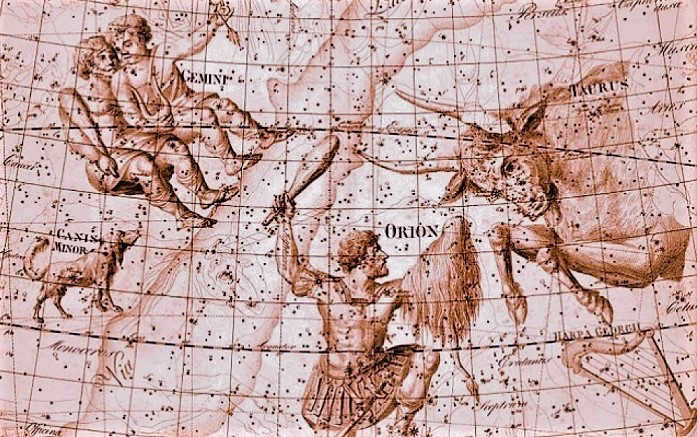

An old chart of the celestial sphere
Scientists named sections of the starry sky as constellations for a simple reason. The constellations form a system of star groups that help facilitate the study of outer space. Essentially, dividing the sky into separate sections is necessary for the convenience of exploring the universe.
Perhaps you are wondering: what types of constellations exist? There is a wide variety of constellations.
Firstly, there are the famous zodiacal constellations. These star clusters are traversed by the Sun throughout the year. It is not widely known that there are actually more than the commonly believed 12 zodiacal constellations. In reality, there is a 13th zodiacal constellation called the Serpentine.
Secondly, there are the equatorial constellations, which are located where the celestial equator passes through.
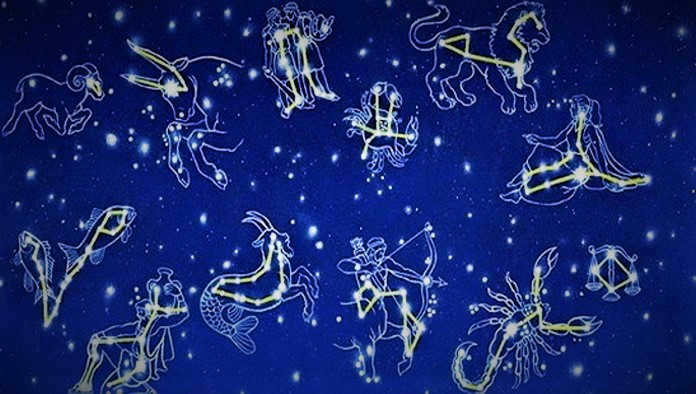
Currently, there are officially recognized and accepted 88 regions of stars. As a result, the celestial space has been divided into distinct areas. These regions have defined boundaries and, interestingly, most of them contain notably bright stars. They are identified by Greek letters, such as Alpha, Beta, Gamma, and others. These designations are used when sorting out constellations based on their composition.
Thanks to these prominent stars, it is effortless to locate specific constellations and the objects within them.
Furthermore, there are established stars that are situated within other formations. These objects are known as asterisms.

An asterism called the Northern Cross can be found in the constellation Swan.
Throughout the year, certain constellations are more prominent in the night sky, and some can only be seen from specific locations on Earth. As a result, star systems are often categorized into constellations of the northern and southern hemispheres. Additionally, there are groups of stars that are associated with different seasons, such as summer, spring, fall, and winter. The visibility of these constellations depends on the observer’s location and the time of year.
Civilizations rise and fall, but the stars endure and will continue to shine eternally.
Galactic Express 999
The Marvelous Constellations of the Universe
But what exactly are constellations? Well, they are remarkable regions of the vast and mesmerizing celestial expanse.
Delving into their mysteries is not only crucial for navigation and delving into the mysteries of the cosmos. Each constellation holds its own unique allure and fascination. Rest assured, there will never be a dull moment when observing these celestial wonders.
Additionally, scientists have made the incredible discovery that the positions of stars in constellations shift over time. Granted, this is an exceedingly gradual and unhurried process. Yet, it is undeniably captivating.

What is the meaning of constellations?
What do constellations represent?

Breathtaking star formations observable in Russia
Russia offers a stunning view of some of the most captivating star formations in the northern hemisphere, including the renowned Orion, Ursa Major, Taurus, Canis Major, and Canis Minor constellations.
By examining their arrangement and letting your imagination run wild, you may perceive a captivating hunting scene, reminiscent of an ancient fresco, that has adorned the night sky for over two millennia. The valiant hunter Orion is always portrayed in the midst of various creatures. Taurus charges towards him, prompting the hunter to brandish his club in defense. Loyal companions, the Great and Little Dogs, rest faithfully at Orion’s feet.
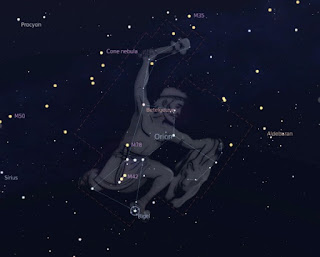 The Orion constellation: a majestic and vibrant celestial formation
The Orion constellation: a majestic and vibrant celestial formation
The Orion constellation, known for its grandeur and vividness, is a prominent feature of the night sky during the autumn and winter seasons. It spans across the entirety of Russia, captivating observers with its remarkable arrangement of stars that closely resembles the outline of a human figure.
The origins of this constellation can be traced back to ancient Greek mythology. According to the legends, Orion was a courageous and mighty hunter, born to Poseidon and the nymph Emvriala. He frequently joined forces with Artemis in their hunting endeavors, but a fateful encounter resulted in his demise. Defeating Artemis in a hunt, Orion was fatally struck by the goddess’ arrow. In honor of his valiant spirit, he was immortalized as a constellation in the night sky.
The most brilliant star in Orion is Rigel. With a bluish-white radiance, Rigel is a supergiant and is considered 25 thousand times brighter than the Sun and 33 times its size. However, despite its impressive dimensions, Rigel is still smaller than Betelgeuse.
Betelgeuse, located on the right shoulder of Orion, is a massive star. It is 450 times the diameter of the Sun, and if it were placed in the Sun’s position, it would extend to the four planets up to Mars. Betelgeuse shines 14,000 times brighter than the Sun.
In addition to these stars, the constellation Orion also includes a nebula and asterisms.
The constellation known as Taurus
The constellation Canis Major
This constellation is part of the Orion family and is surrounded by the constellations Orion, Unicorn, Canis Minor, and Lepus.
The discovery of the Big Dog constellation dates back to the second century when Ptolemy first observed it.
Legend has it that the Big Dog was once known as Lelap, a remarkably swift dog capable of outpacing any prey. In a race against a fox, which proved to be equally fast, Zeus intervened and turned both animals into stone. He then placed the dog in the sky, forming the constellation.
The Big Dog constellation is particularly prominent during the winter season. The most prominent star in this constellation, as well as in all other constellations, is Sirius. Sirius has a bluish radiance and is relatively close to Earth, located at a distance of 8.6 light years. While it is outshined by Jupiter, Venus, and the Moon in our solar system, Sirius still emits a significant amount of light. The light from Sirius takes 9 years to reach Earth and is 24 times brighter than sunlight. Additionally, Sirius has a companion star known as Puppy.
The concept of “Vacation” is closely linked to Sirius. This is because Sirius appears in the sky during the hot summer period. In Greek, Sirius is called “kanis”, so the Greeks started referring to this period as vacation.
The constellation Canis Minor
The star formation Big Dipper
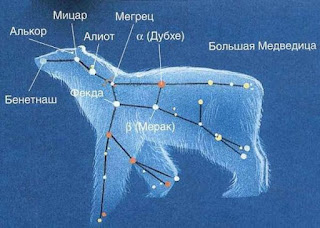
Dubhe, a red giant, serves as a marker for Polaris. Positioned 120 light years away from our planet, it’s a remarkable sight.
Alkaid, the third most luminous star in the constellation, signifies the end of the Big Dipper’s tail. It is located 100 light-years from Earth.
Aliot, the brightest star in the constellation, represents the tail. Its brilliance makes it an invaluable navigation aid. Aliot shines 108 times brighter than our Sun.
These constellations are the most radiant and exquisite in the northern hemisphere. They can be observed perfectly with the naked eye on a crisp autumn or wintry night. The legends surrounding their formation allow the mind to wander and envision the mighty hunter Orion, accompanied by his loyal hounds, chasing after their quarry, while Taurus and the Big Dipper keep a close watch.
Back in the olden days, the vast expanse of stars provided a roadmap for wanderers. Individuals connected the most luminous stars together, forming shapes that were assigned the titles of Greek mythological heroes, animals, and objects. As new stars were unearthed, the parameters of these constellations shifted. However, in 1935, astronomers made the decision to halt any further revisions to the established boundaries.

Cluster of Stars
A cluster of stars that are relatively close together is commonly known as a constellation. However, this is not an accurate definition. Let’s provide the correct explanation of what a constellation truly is.
In modern astronomy, a constellation refers to specific regions of the sky where the traditional constellations are situated. There are a total of 88 such designated areas. The division into sections has facilitated navigation among the stars. Each section contains numerous stars and galaxies, in addition to the ones traditionally associated with the constellation.
The most significant star formations
In terms of importance, the Big Dipper and Little Dipper constellations have held a prominent place for a long time in the Northern Hemisphere. These constellations have played a crucial role in accurately determining the northern position by relying on Polaris. Additionally, another noteworthy star formation that is always visible in the nighttime sky is the constellation of Cassiopeia.
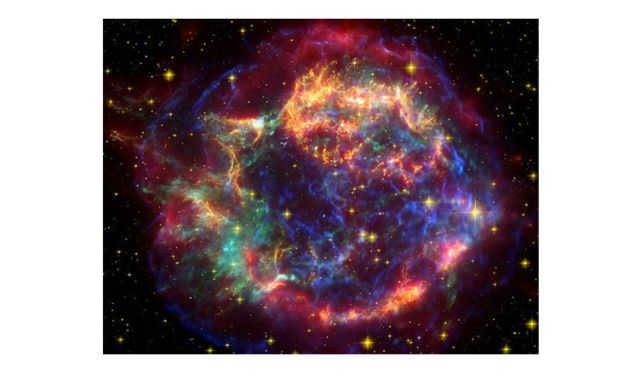
Figure 1. A photo of the constellation Cassiopeia taken by the Spitzer Space Telescope.
In the Southern Hemisphere, there is a constellation called the Southern Cross, which cannot be seen north of the Tropic of Cancer (the Northern Tropic). The Southern Cross is often used as a guide to determine the direction towards the south.
There are a total of 7 luminous stars within the constellation. Their configuration bears a resemblance to a shallow receptacle with an elongated, curved handle. In its entirety, the constellation encompasses more than 200 stars and over 3,000 galaxies. The light emitted by the most remote star takes approximately 13 billion years to reach Earth. This information has been derived from observations made by the Hubble Space Telescope.
If you were to extend the opposite side of the handle, it would align the Big Dipper with Polaris. By drawing a perpendicular line from Polaris to the horizon, you would determine the northward direction. Polaris represents the end of the handle of the Little Bear’s scoop. This constellation possesses a lesser degree of brightness.
The 5 central stars within the constellation belong to the same grouping, while the two outermost stars move in a different direction. Over the course of 100,000 years, the shape of the Big Dipper will undergo alterations.
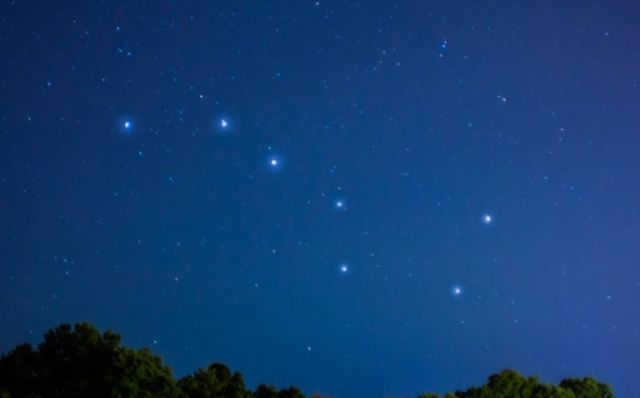
The Southern Cross constellation
The Southern Cross constellation is situated in the smallest part of the sky. It is composed of four bright stars that form the shape of a cross. This cross is made up of a long bar and a short bar. By extending the longer bar 4.5 times its length, the direction south can be determined by the perpendicular to the horizon.
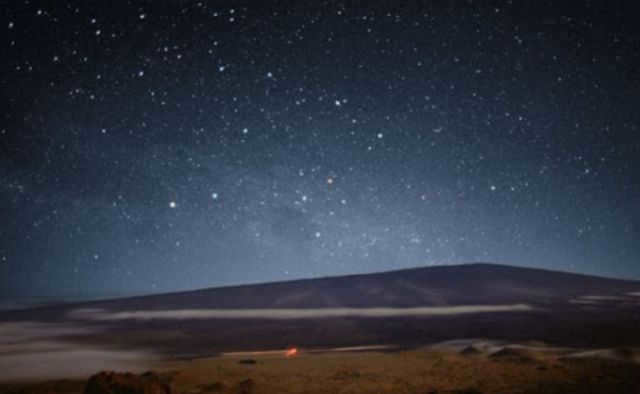

Figure 3. The Southern Cross constellation.
Ancient Roman philosopher Ptolemy (2nd century) wrote about this constellation. The constellation is easily recognizable by the dark nebula known as the Coal Sack and the star cluster called the Casket of Diamonds (which contains more than 100 stars).
The Southern Cross could be seen from the territory of modern Russia until 2000 B.C. It will become visible in the sky again starting from the year 14000.





